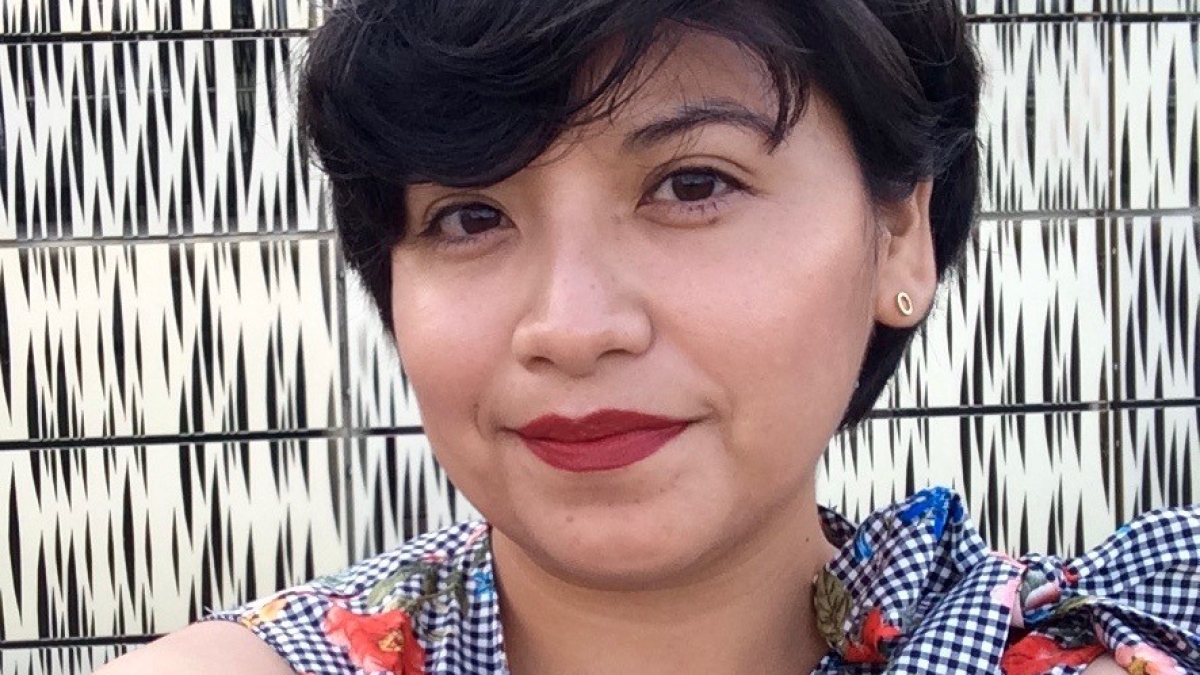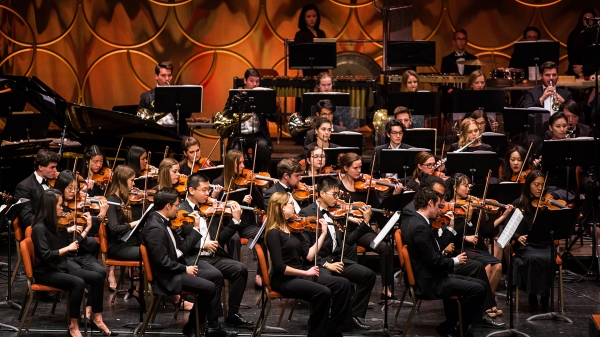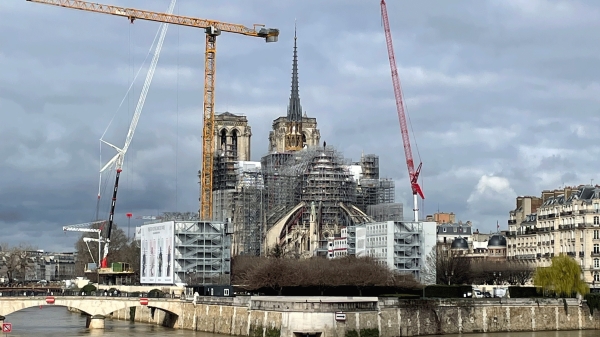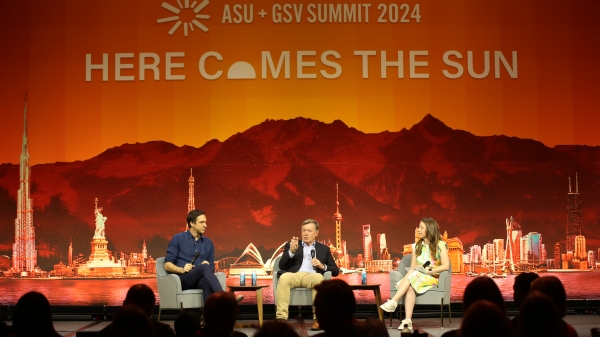A place at the table: ASU grad writes for community

Maritsa Leyva Martinez received a Piper Global Teaching Fellowship for a summer residency at the National University of Singapore in 2017. She snapped this selfie while visiting Singapore's National Gallery.
Editor’s note: This is part of a series of profiles for spring 2018 commencement.
For ASU student Maritsa Leyva Martinez, fiction writing is a community endeavor. Her love for the craft began in a community setting — a nonprofit literary organization — and has continued at ASU in her work as a citizen-artist.
Martinez is graduating with a Master of Fine Arts in creative writing (fiction) after defending her thesis, an interconnected collection of short stories titled “Fiesta Inn Motel.” Like her stories, Martinez’s activities are interconnected: her advocacy work, born of her desire to assist children who cross the border without family; and her writing, committed to honoring the human condition as well as the places and neighborhoods she sees as fundamental to the immigrant experience.
Born in Guerrero, Mexico, and raised in Houston, Martinez’s unique voice has distinguished her among her peers. She was the international editor for ASU’s award-winning literary magazine Hayden’s Ferry Review and, among other honors, received a Piper Global Teaching Fellowship for a summer residency at the National University of Singapore in 2017.
Martinez’s mentors affirm her as a valued teacher, student and peer: “Maritsa is a talented writer and a wonderful, caring member of our community,” said Jenny Irish, assistant director of the Department of English’s creative writing program.
We sat down with Martinez to find out how she arrived at this juncture and what she’s planning to do next.
Question: What was your “aha” moment, when you realized you wanted to study in your field?
Answer: It was early mid-2014 and I had recently finished an internship at Houston’s Alley Theatre, in the Education and Community Engagement Department. In the midst of that and tutoring for a local agency, I decided that I would try writing again. I had dabbled in writing a little in high school and a little more in undergrad, but I didn’t stick with it. Mostly because I felt apprehensive about my ability in the art and methods of creative writing. There was so much that I had left to learn, so much left to read. With that renewed sense of adventure, I enrolled in two summer writing workshops at Inprint, a magnificent literary nonprofit organization. I spent June and July going back and forth between fiction and poetry. Of course, I gravitated toward fiction. It was at Inprint, under the tutelage of authors Jameelah Lang and David Tomas Martinez, that creative fiction methods began to make sense for the first time in my life. It was there that I began to learn about basic plot structures, chronic tension and shifting forms of narrative, etc.
At the end of my time at Inprint I had a short story draft entitled “At the Corner of Manel and Frieda” and I had Jameelah’s feedback — “Your prose is incredibly distinct and beautiful, and this alone is able to carry me though the duration of your draft” — which I held onto like a life raft. This feedback sat beside me at every stage of the MFA application process, and, as the saying goes, the rest is history.
Q: What’s something you learned while at ASU — in the classroom or otherwise — that surprised you, that changed your perspective?
A: My mentors — T.M. McNally, Tara Ison, Alberto Ríos, Angie Dell, Matt Bell, Jenny Irish, Melissa Pritchard, Cynthia Hogue and Jennifer Cason — each of them in their own words, in their own way always only said, “YES! Yes, take the risk. Yes, that is the journey to take. Yes, I will help you get there. Yes, I believe in you, but believe in yourself.” Their dedication and mentorship was vital to my success as student, as teacher. For the last year I have served as Professor Alberto Ríos’ graduate assistant and working beside him, witnessing his love of community really helped solidify my own perspective about the power of the individual and the power of words.
What I learned is that as a Mexican-American immigrant writer, in order to write and honor the human condition as I have witnessed it, as my community has witnessed it, I need to participate in the formation of my community’s identity. I need to find ways to engage the cultural structures that are working for my community; and, also, ways to learn from, infiltrate and expose those structures that are, in a sense, dismantling my community, through acts of terror, through the building of borders, through unjust prosecutorial measures (deportation, detention, persecution and fear mongering). Most importantly, I learned that to be a writer is to be a citizen.
Q: Why did you choose ASU?
A: Oh, the reasons!: the faculty (all genuinely concerned and invested in their community and their students); the teaching assistantship, which offered the opportunity to teach introductory creative writing to undergraduates; and the diverse opportunities available via the Virginia G. Piper Center for Creative Writing. All of these factors influenced my decision to attend ASU — and what a journey it has been. I am infinitely grateful to have been granted a place at the creative writers’ table here.
Q: What’s the best piece of advice you’d give to those still in school?
A: Don’t be afraid to forge your own path. Degree requirements are requirements, but that doesn’t mean you can’t get creative with them. You, the student, are the most important piece of the institution, and it is up to you to demand your worth.
Q: What was your favorite spot on campus, whether for studying, meeting friends or just thinking about life?
A: The Piper Center and its little garden.
Q: What are your plans after graduation?
A: I want to teach in the nonprofit sector. Currently I volunteer as a child advocate with the Young Center for Immigrant Children’s Rights. Through my volunteer work I have visited several children detention centers, which are underfunded and understaffed. I know that my MFA in creative writing degree and my past teaching experiences in Mexico and at ASU are needed there most.
Q: If someone gave you $40 million to solve one problem on our planet, what would you tackle?
A: In Houston, the BakerRipley organization, formerly Neighborhood Centers, works side by side with community leaders and residents to improve community development in underserved communities. They have several education community centers and senior service centers. Because I greatly admire their work, I would invest $20 million with BakerRipley, specifically to help set up community garden centers in elementary schools located in neighborhoods lacking ready access to healthy, fresh food.
Once the program was in place, I would invest money in qualified staff, who would see to the program’s success for a minimum 10 years. One of the highest factors in program failure, as has been my experience with nonprofit initiatives, is the lack of qualified staff retention. The other $20 million I would invest in doing the same thing, but in Maryvale, North Mountain, Central City and Encanto in Phoenix.
More Arts, humanities and education

ASU Symphony Orchestra welcomes visionary conductor Jonathan Taylor Rush
Guest conductor Jonathan Taylor Rush will join Arizona State University’s Jason Caslor, director of bands, to lead the ASU…

Chemistry classes are key to art student's success
Amanda Barnette has a passion for art preservation. That means that, for the past four years, the Arizona State University…

ASU+GSV Summit tackles big questions about AI, technology, education
Editor's note: We'll be updating this story daily throughout the summit. The annual ASU+GSV Summit kicked off in San Diego on…